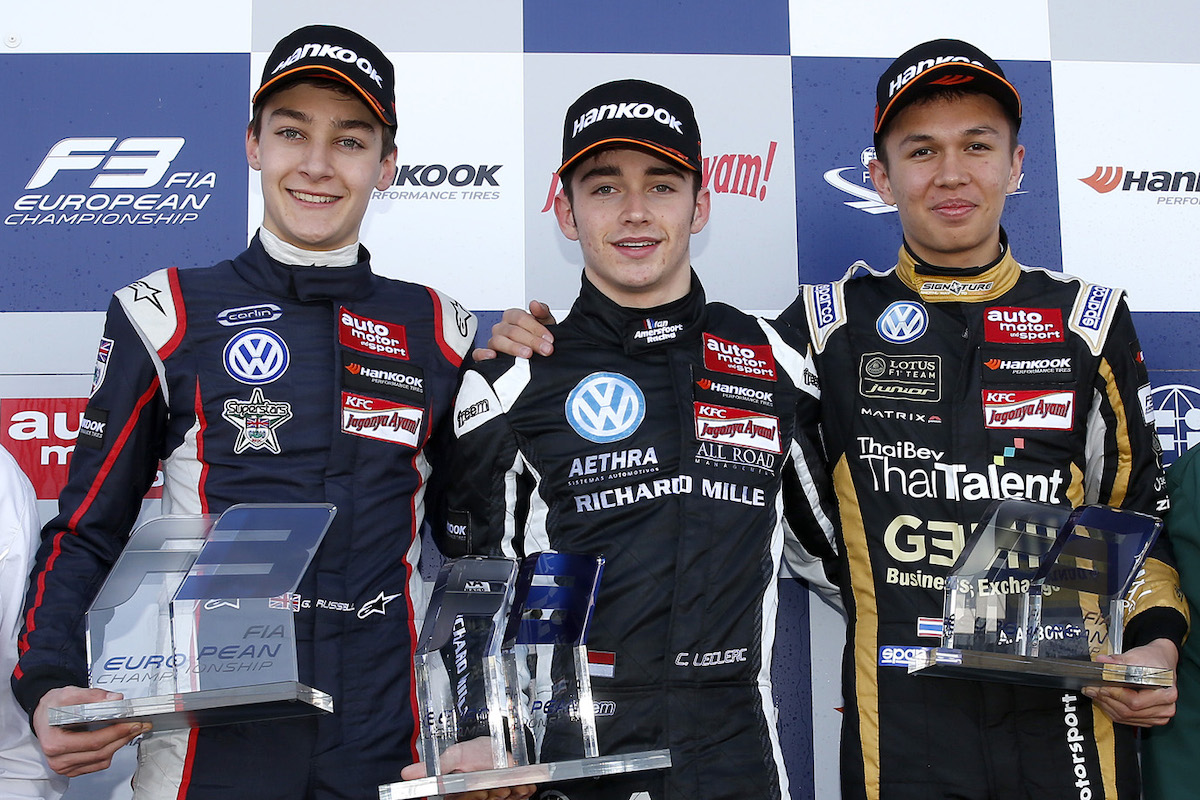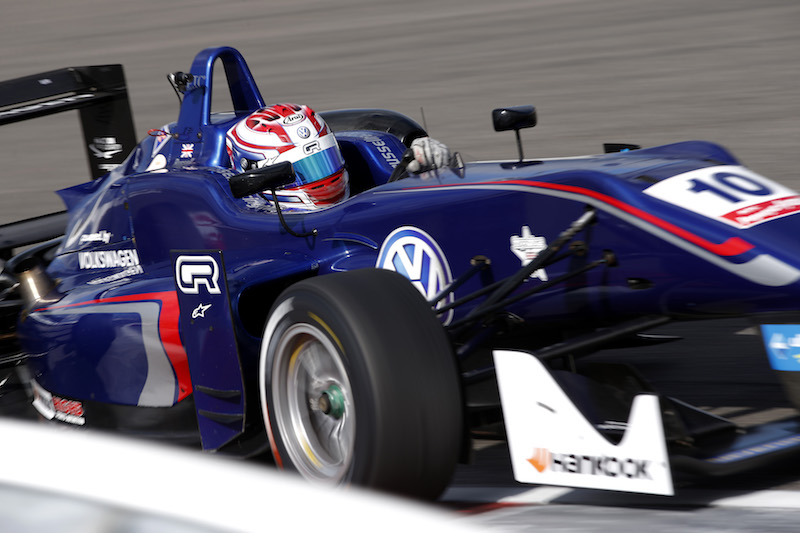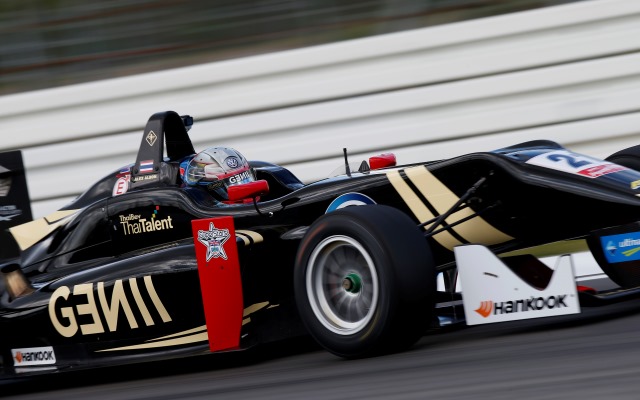
Charles Leclerc, Alex Albon and George Russell lit up lockdown with their Twitch antics. Peter Allen remembers when the trio raced each other as F3 rookies, and each stood out in a different way.
One of the highlights for Formula 1 fans of the ‘lockdown’ period induced by the coronavirus pandemic has been watching drivers racing each other online, streaming their antics on Twitch and and interacting with each other over Discord.
While it was nothing new for Lando Norris, several of his peers also jumped into it head-first, and the dynamic between Charles Leclerc, Alex Albon and George Russell was particularly enjoyable: whether they were fighting for the win in F1’s official Virtual Grand Prix series, driving backwards together with Leclerc and Albon’s younger brothers, or messing around on lawnmowers.
The three were already good friends before they made it to F1. A well-circulated photo shows them hanging out inbetween kart races in 2011, when they were all driving for the same Intrepid team together with Harrison Scott, who is usually cruelly cropped out of the image.
At the time, a 15-year-old Albon was in his final year of karting in the senior KF1 and KF2 classes, finishing second in that year’s world championship. Leclerc and Russell, two years younger, were in the junior KF3 category – Leclerc won the World Cup before moving up to KF2 with ART, while Russell claimed the first of his two consecutive European championship titles.
With Albon struggling to find his feet in Formula Renault, he was joined in the category by single-seater newcomers Leclerc and Russell in 2014 – although their contrasting schedules across multiple championships meant the trio didn’t actually share a track during a race all year.
For 2015, their next steps were all the same: a move up to the FIA Formula 3 European Championship. After Esteban Ocon and Max Verstappen had taken the series by storm as debutants in the previous season, it was all eyes on the new crop of rookies to see who would follow in their footsteps.

Photo: Paul Davies Photography
The Verstappen effect on the series had been considerable, with a total of 35 drivers entering the early rounds with varying levels of experience. Some were, like Verstappen before them, fresh out of karts, such as Callum Ilott and Alessio Lorandi.
Pre-season, Leclerc was the most hotly-anticipated of the rookies. After his glittering karting career, he had finished second to veteran Nyck de Vries in the Formula Renault Alps series in 2014 and – perhaps more impressively – taken a trio of second-place finishes from a handful of appearances in the hugely-competitive Eurocup.
While all the rookies would no doubt have liked to be driving for the all-conquering Prema (Leclerc and Albon both conducted early tests with the team), team owner Lawrence Stroll wasn’t going to be forcing his boy Lance to share an awning with another highly-rated newcomer.
Leclerc and his manager Nicolas Todt instead signed with Van Amersfoort Racing, no doubt inspired by what former karting rival Verstappen had been able to achieve with a team that had previously been considered a bit of an also-ran at European level.
It soon looked like the move would pay off. Leclerc arrived for the opening round at Silverstone having blitzed pre-season testing, both at Valencia and at the British circuit earlier in raceweek.
Russell’s step up to F3 was also eagerly-anticipated, even though it hadn’t even been his plan initially. Although he’d won the BRDC British F4 title in 2014, it had taken an impressive comeback to prevent him being denied by team-mate Arjun Maini, after a mid-season bout of chicken pox halted his early momentum.
In a parallel Formula Renault Alps campaign, he’d struggled to match the heights of Leclerc, but did win on a Eurocup guest appearance in the season finale. A full season in the Eurocup was on the cards for 2015 before Russell won the McLaren Autosport BRDC Award, which encouraged him to move up to F3 with Carlin.

Come qualifying at Silverstone, it was Russell that got the edge over Leclerc – just, by 0.033 seconds – for fourth on the grid. But the pair could hardly have made a worse start to their season when they collided in the very first corner of green-flag racing. Leclerc went up the inside of Russell at Vale after a safety car start on a wet track and lost control, sending both drivers spinning.
Both recovered well, Russell finishing eighth with a broken wishbone, Leclerc taking 12th via the pits. But top rookie honours (in fourth overall behind Felix Rosenqvist, Antonio Giovinazzi and Jake Dennis) went instead to Albon, who was first to profit when Russell and Leclerc tangled and left Brandon Maisano with nowhere to go.
Relative to some, not much had been expected from Albon heading into the year. He had finished third in his third season in the Eurocup in 2014, but without winning a race. His step into F3 came with the Signature team – previously a category powerhouse but returning after three years away – and his team-mate was fellow Lotus F1 junior Dorian Boccolacci, who had just a year in French F4 to his name. But this, combined with sixth places in the other two races at Silverstone, was a promising start.
The weekend ultimately belonged to Leclerc and Russell though. When scrutineers excluded Rosenqvist from the second qualifying session, Leclerc was handed pole for races two and three. Russell made a better start to race two from alongside him on the front row, and absorbed the pressure from his rival to take the win. Leclerc made amends to win race three, ensuring both he and Russell had emulated Ocon by winning on their first F3 weekend. And on that form, both looked capable of winning the title, too.
In the end it was Leclerc that kept the Ocon-like form going, at least for a while. He took another win in the next round at Hockenheim when he triumphed against the wily Rosenqvist in an epic wet-weather battle. He extended a streak of eight consecutive podiums through the Pau Grand Prix weekend, and another victory at Spa – when Giovinazzi and Rosenqvist collided while he was battling with them – put him into the championship lead.

There was a fourth win, again in the rain, at the Norisring, but he didn’t even score another podium over the remaining five rounds. He wasn’t the same after a big crash at Zandvoort induced by suspension failure, and he faded to fourth in the points.
That did nothing to negate just how impressive Leclerc had been in the early rounds, though. Mixing it with experienced F3 campaigners like Rosenqvist and Giovinazzi, and outscoring them in the standings aged 17 had proven just how good he was.
He also provided a reminder of his talent at the end of the year at the Macau Grand Prix, where he finished second to Rosenqvist after a valiant fight. By then, he was already on course to join the Ferrari Driver Academy and move into GP3. And the rest, as they say, is history.
While the wins dried up mid-season for Leclerc, Russell never added to his tally after Silverstone. Qualifying was his achilles heel and prevented any more big results, but also gave him a chance to impress in another way – with his racecraft. It wasn’t just his ability to make up positions that stood out, but more that he could do it in a clean manner.
After all, this was a season in which the European F3 field caught the attention for poor driving standards rather than the talent within it. But Russell didn’t fail to finish until he was innocently taken out of the of the 33rd and final race of the season.
Finishing sixth in the standings, Russell’s results might not have been headline-grabbing, but his efforts did impress talent spotter Gwen Lagrue – in the F3 paddock with Albon and Boccolacci in his role with Gravity Sports Management, and already familiar with Russell from karting.
Lagrue would follow another of his proteges Esteban Ocon to the Mercedes junior programme after the closure of the Lotus F1 team, and ensured Russell got a chance on the Mercedes simulator during his second season of F3 with Hitech in 2016. Even though Russell couldn’t defeat the Stroll-Prema juggernaut on track, he did enough in the sim to earn the backing of Mercedes, with which he would claim back-to-back titles in GP3 and Formula 2 on his way to F1.

And what about Albon? Again, he didn’t win a race, but he was a consistent presence in the top 10 and showed a brilliant turn of speed at times. One such occasion was at the Norisring, where he, Leclerc, Russell and future Formula E ace Maximilian Gunther were all up at the sharp end on their first time at the Nuremberg street track. Albon claimed a double pole in the second qualifying session, although he was outfoxed in the races.
He managed a similar qualifying achievement at Portimao, where he was the only driver to rival the otherwise dominant Prema team. A technical infringement cost him the double pole position though, and he had to make do with a second-place finish in the opening race instead. With five podiums to Russell’s three, he ended up just 16 points shy in the standings.
While the collapse of the Lotus F1 team meant Albon parted with a junior programme for the second time in three years, he did continue to be guided by Lagrue, and landed a top GP3 seat with ART for 2015 – a year before Russell. It would be a true breakout season, as he battled team-mate Leclerc for the title and proved himself as a top prospect. But it was rivalling Russell – and Lando Norris – in F2 two years down the line that would earn him his unexpected F1 shot.
In the case of all three drivers, 2015 wouldn’t be the most successful season of their respective junior careers when it came to race wins or championship positions. But it would be a crucial one in their development en route to racing together once again in F1 – both virtually and in reality.
Further reading
How George Russell developed to become Williams’ ideal driver
The inside story of how Alex Albon earned one of F1’s top seats